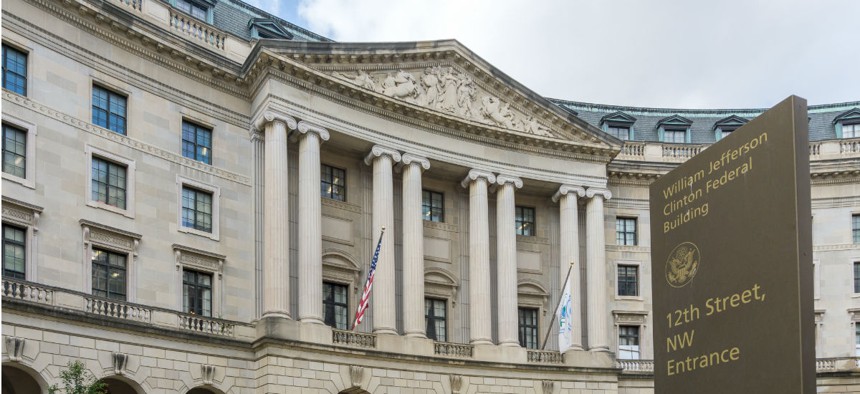
Erik Cox Photography/Shutterstock.com
EPA’s Bid for ‘Consistent and Transparent’ Rulemaking Draws Fire
Some scholars welcome review of cost-benefit analysis, but consumer groups see risks.
One enduring legacy of former Environmental Protection Agency chief Scott Pruitt may be a rule that recasts the agency’s approach to the complex art of cost benefit analysis in weighing regulations.
On June 7, less than a month before he resigned, Pruitt announced a coming proposed rulemaking and comment period via an advance notice titled “Increasing Consistency and Transparency in Considering Costs and Benefits in the Rulemaking Process.”
Pruitt made pointed comments about the need to reduce confusion and uncertainty for states: “Many have complained that the previous administration inflated the benefits and underestimated the costs of its regulations through questionable cost-benefit analysis,” he said. “This action is the next step toward providing clarity and real-world accuracy with respect to the impact of the agency's decisions on the economy and the regulated community.”
The purpose of the notice, EPA added, was to “request more information about the nature and extent of issues raised by stakeholders regarding EPA practices in considering costs and benefits” when designing rules to curb, for example, air pollution.
That comment period, extended in July, ended this Monday, with 3,241 total comments, according to Regulation.gov.
That same day, an array of environmental, progressive and consumer groups—including EPA alumni—denounced the plan as a threat to public health, asking acting EPA Andrew Wheeler to toss it.
A statement from members of the Environmental Protection Network and Save EPA, two volunteer groups of former agency employees that had filed joint comments, called the proposal “ill conceived and unnecessary” and raised concerns that it could be used to undermine public health and environmental protections. They stressed that “cost-benefit analysis is a respected, time-tested tool for describing, in an integrated way, the quantifiable and non-quantifiable benefits and costs of regulatory alternatives for decision-makers and the public.”
On the same day, a similar message with filed comments was issued by 85 nonprofits reflecting a range of interests, among them the Center for Progressive Reform, Californians for Pesticide Reform, the Center for Media and Democracy and the Chattahoochee Riverkeeper.
“While cost-benefit analysis may sound like an inside-Washington technicality, it can and does have profound implications for a variety of rules that affect the air we breathe, the water we drink, the food we eat, the chemicals we're exposed to, and much more,” they wrote. As one commenter wrote of the notice’s background text, “Entire categories of crucial benefits are simply left out, either because they involve values like dignity or equality that cannot be measured in dollar terms, or because we lack the data or models necessary to quantify the relevant public health and environmental risks.” Pruitt’s announcement “largely glosses over these concerns with EPA’s past experience with cost-benefit analysis,” the commenter added. “It makes no mention of the widespread consensus in the academic and policy literature that the systematic undercounting of benefits poses a significant problem for the practical utility of cost-benefit analysis.”
Pro-business groups welcomed Pruitt’s original announcement. Marlo Lewis Jr., a senior fellow at the Competitive Enterprise Institute, said that leftist environmentalists should not be alarmed at a rulemaking that is “hardly the stuff of either skullduggery or heroism.”
The need for greater consistency and transparency at EPA, he wrote in summarizing the notice, stems from statutory provisions that fail to adequately define key terms as well court decisions that have expanded the concept of cost. EPA’s ability to estimate costs is “limited by the state of scientific and economic modeling, quantification methods, and available data—all of which change over time and across industries and sectors of the economy,” Lewis wrote.
Also weighing in were academics at the George Washington University Regulatory Studies Center. “Regulatory impact analysis is essential for transparently evaluating the pros and cons of alternative policy choices before they are put in effect,” the project’s director, Susan Dudley, told Government Executive. “Every president since Carter has required benefit-cost analysis, and courts are increasingly expecting important regulatory decisions to be supported by it. While regulatory analysis isn’t a cookbook exercise, EPA could increase consistency and transparency by reviewing all its statutory authority and, to the maximum extent possible, interpreting its statutory standards as permitting, if not requiring, benefit-cost analysis.”
Her colleague Brian Mannix wrote that cost-benefit analysis should be viewed, “not simply as an internal tool for the agency’s use, but as an external check on administrative discretion. [It] increasingly is (and ought to be) scrutinized not only by reviewers in [the Office of Management and Budget] and elsewhere in the executive branch, but also by the courts.”
His colleague Joseph Cordes, noted “there is no rationale, either in economics, or in OMB guidance for not fully counting indirect benefits and costs of EPA regulations when appropriate in addition to direct or primary benefits or costs. Proper inclusion of environmental co-benefits, however, does require that attention be paid to how the baseline is defined, and to symmetric treatment of indirect costs as well as indirect benefits.”
Image via Erik Cox Photography/Shutterstock.com.







